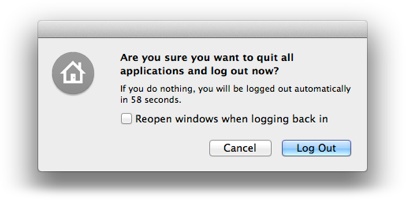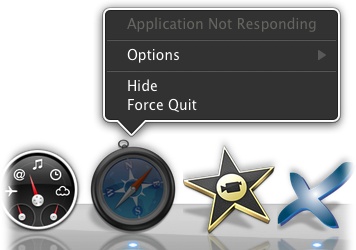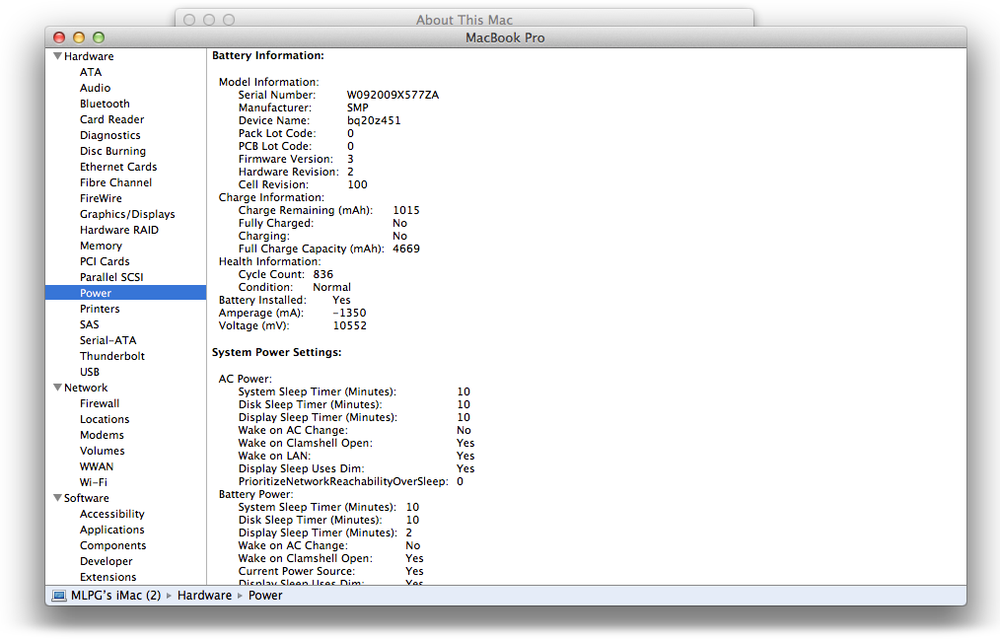OS X Mountain Lion Pocket Guide (12 page)
Read OS X Mountain Lion Pocket Guide Online
Authors: Chris Seibold
Tags: #COMPUTERS / Operating Systems / Macintosh

When you use an app on an iOS device, the app starts up
right where you left off the last time you ran it. Mountain Lion can do
this, too, thanks to Resume. If you quit Safari with 10 windows open,
those same windows will pop open when you restart Safari. Resume also
works when you shut down or log out: when you restart or log back in, all
the apps you were using automatically relaunch and open all the windows
you had open before.
Resume works just like it did in Lion, which is great if you liked
Resume. Unfortunately, Resume is one of those love-it-or-hate-it deals. If
you're in love-it camp, you don’t have anything to worry about. If you
hate it, you can make your Mac much more tolerable with just a few steps.
First you’ll want to make your Mac close windows when quitting an app.
Head to →
→
System
Preferences
→
General, and then check the
box next to “Close windows when quitting an application.” This will keep
Mountain Lion from restoring open windows when you relaunch an
application, but it won’t keep Mountain Lion from reopening all the apps
you had running the last time you logged in when you log back in, and that
can be annoying, too. To make your Mac start without restarting every app
you had running when you logged out, make sure the checkbox shown in
Figure 3-36
is unchecked (the
dialog box in
Figure 3-36
pops up when you log out).

Figure 3-36. Keep this box unchecked if you hate having apps
auto-start
OS X is a robust operating system; while problems are rare, they do
show up from time to time. Since these issues always seem to present
themselves at the worst possible moment, it helps if you know the best ways
to troubleshoot them. That’s what this chapter is all about, and it’s a
great reason to keep this book in your pocket!
There are a lot of things that can go wrong with your Mac:
Hardware problems, software glitches, and configuration issues can happen
at any moment. Most of the problems you’ll encounter can be easily
addressed or diagnosed by following the steps in this chapter.
However, some issues are unusual or won’t respond to the
fixes listed in this chapter. A great resource for those situations is
Apple’s website:
www.apple.com/support
.
As you’d expect, you can browse manuals and tutorials on that site. More
useful when trying to fix that quirky problem, though, are the communities
you can access via that site, where you’ll likely find someone who’s
having the same problem you are—and the fix.
If the information there doesn’t resolve things, you could have a
unique issue, in which case a trip to your local Apple Store or a call to
Apple is in order. You can find a complete list of technical support
numbers for Apple at
www.apple.com/support/contact/phone_contacts.html
.
In the United States, the number is 1-800-275-2273.
One of the most common problems on a Mac is an application
that isn’t behaving as expected. This issue comes in many forms: an
application that unexpectedly quits repeatedly, stops responding, or
just doesn’t perform the way it normally does. This section suggests
ways to resolve all these issues and more.
Occasionally, an application will simply stop reacting
to anything. Your mouse or trackpad will still work, and other
programs will be fine, but if you want to use the troublesome program,
all you’ll get is a spinning beach-ball cursor (instead of the mouse
pointer) and you’ll have no way to input anything.
Don’t panic—there’s an easy fix. Simply right-click or
Control-click the stalled application’s icon in the Dock to bring up
its Dock menu (
Figure 4-1
). If you see
Application Not Responding in faint text at the top of the menu,
you’ll also see a Force Quit option. Select Force Quit and OS X will
kill the program.
You may also need another way to kill applications, because
occasionally a program can become unresponsive without OS X realizing that the program is in
peril. For these times, launch the Force Quit Applications dialog box
either by selecting →
→
Force Quit or
using the key combo Option-⌘-Esc. You can also try holding down Shift
as you click the menu, then select “Force Quit [application
menu, then select “Force Quit [application
name]” to kill the frontmost application.
There’s some good news when it comes to force quitting
applications in Mountain Lion. In the old days of OS X (before Lion),
any changes you made between the last time you saved a document and
the moment the application started misbehaving were gone forever. But
thanks to Auto Save, if you’re forced to quit an application, Mountain
Lion preserves the work you’ve done since the last time you manually
saved.

Figure 4-1. Force quitting Safari
“Save early, save often” is still good advice, since Auto Save
works only with applications specifically built with Auto Save in
mind. That means that work you do in apps designed for Lion or
Mountain Lion will be saved, but applications that haven’t been
updated since Lion came out
won’t
automatically
save your work.
The Finder is just another program, so it can get hung
up, too. If that happens, either head to →
→
Force Quit or
use the key combination ⌘-Option-Esc. If nothing happens, try clicking
the Dock or some other application first, and
then
use the menu or ⌘-Option-Esc to invoke the Force Quit
menu or ⌘-Option-Esc to invoke the Force Quit
dialog box.
When you select an application in the Force Quit
dialog box, the dialog box’s button reads “Force Quit.” However, if
you select the Finder, the button reads “Relaunch” instead. Why?
Unlike every other application, the Finder will be restarted
immediately after it’s forced to quit.
If you suspect something is eating up too much processor
time or hogging too many system resources (because your Mac is running
really slowly, say, or the fans are running at full speed for no
obvious reason), Force Quit won’t help you figure out which
application is the culprit. Instead, open Activity Monitor
(Applications
→
Utilities
→
Activity Monitor), click its CPU tab in the
lower half of the window, and then look for any processes that are
using a lot of CPU resources for more than a few seconds. (Safari and
its helper applications occasionally do this, particularly with
runaway Flash or JavaScript code.) When you identify a suspect,
single-click the renegade process’s name and then click the big red
Quit Process button (you can’t miss it—it’s shaped like a stop
sign).
Be careful which applications you quit in this way. There are
some programs that your Mac runs in the background, and many of
these are important in helping your computer operate normally.
Here’s a rule of thumb: if you don’t recognize the name of the
program as an application that you launched, don’t kill it. Instead,
do a Google search on its name (for good measure, include the terms
“OS X” and “cpu,” too). Chances are good you’ll find a solution for
whatever is causing that process to use up so much CPU
time.
It seems like computers never have enough USB ports, so
most of us end up using USB hubs (or keyboards that have extra USB
ports). Then we plug some fantastic new USB device into the hub—and it
doesn’t work. In fact, if you dig through System Information (it’s in
the
/Applications/Utilities
folder) and look at
the USB Device Tree (click USB in the list on the left), the hub shows
up, but not the device.
Often the problem is that the device requires a
powered
USB port and you’re using an unpowered
hub (or you’ve maxed out the power capabilities of the hub or port).
Switching to a powered hub might fix the problem, but that isn’t
guaranteed. What works most often is plugging the device directly into
your Mac, which means you’ll need to shuffle your various USB devices
around. If any of them can run off of their own external power supply
rather than taking power from the USB port, that may help as well
(sometimes these power supplies are sold separately; check with the
device’s manufacturer).
The second method of attacking USB device problems is a little
more involved. First, shut down your Mac and unplug all the USB
devices (even the ones that use external power supplies). Reboot your
Mac, and then plug them back in one at a time while watching the USB
Device Tree (it’s updated quickly so you’ll see each device appear as
it’s plugged in) to figure out which device isn’t playing nicely with
others. Sometimes going through this process results in all the
devices suddenly working. But if you discover that only a certain
device isn’t working, the fix may be to install a new driver for it.
Check the manufacturer’s website for updates.
MacBook users are faced with a problem that desktop
users don’t have to worry about: the battery. The goal of most Apple
batteries is to still provide 80% of the original charge capacity
after a certain number of cycles (charges and discharges). The number
of cycles varies depending on your machine. For Mountain Lion–capable
MacBooks, the cycle count is either 750 or 1,000 cycles (depending on
the model). If you notice your battery isn’t holding a charge for as
long as it used to, the first thing to do is launch System Information
(Applications
→
Utilities
→
System Information) and then click Power in
the list on the left; see
Figure 4-2
.

Figure 4-2. The Power section of System Information tells you all about
your battery
The Battery Information list includes your battery’s full charge
capacity, how many cycles it’s been through, and its condition. If the
condition is listed as Replace Soon or something equally ominous, it’s
time to think about getting a new battery. If the cycle count is low
but the battery is
still
running out of juice
prematurely, here are a couple of things you can try:
- Calibrate the battery
Inside every MacBook battery is a microcontroller
that tells your computer how long the battery is going to last
until it runs out of juice. Over time, this estimation can get
further and further from real-world performance. To get the
computer and the microcontroller on the same page, you need to
recalibrate the battery from time to time. To do so, fully
charge the battery and then keep your computer plugged into the
power adapter for two more hours. Next, unplug the power adapter
and fully drain the battery. When a warning pops up alerting you
that the battery is running dangerously low, save your work and
keep on trucking until your computer automatically goes to
sleep. Then let the computer sleep for more than five hours to
make sure every drop of power is gone. Finally, plug in the
power adapter and let your computer fully charge. The battery
indicator should now be successfully recalibrated.NoteIf your MacBook has an internal battery, Apple
recommends
not
calibrating the battery
because these internal batteries should be serviced only by an
authorized repair center.- Reset the SMC
SMC is short for the System Management Controller,
a chip that’s responsible for hard drive spin-down, sleeping
your Mac, waking your Mac, and keyboard backlighting. A
malfunctioning SMC can prevent the battery from charging, so you
need to reset the SMC. How you do that depends on whether your
MacBook has an internal battery (like all the newer MacBooks) or
a battery that you can easily remove. If it has a removable
battery, shut it down, unplug the power adapter from the wall
and the computer, and then remove the battery. Next, press the
power button for five seconds. After that, replace the battery,
plug in the power adapter, and then restart the computer. If
your MacBook has an internal battery, shut down the computer and
plug it into an adapter that’s getting power. On the left side
of the keyboard, hold down Left Shift-Control-Option, and then
press the power button. Keep all these buttons depressed
(including the power button) for five seconds and then release
them all simultaneously. Pat yourself on the back for pulling
off an impressive feat of
manual dexterity, and then press the power button to restart the
computer.
If those remedies don’t restore your battery, it’s likely time
for a trip to the local Apple Store or authorized repair center. If
your computer is under warranty and your cycle count is low, Apple
will probably replace the battery for free. If your cycle count is
over the recommended number and the performance degradation is within
expectations, you’ll probably need to pay for a new battery or live
with the reduced (and ever-shrinking) battery capacity.
Like many computer makers, Apple has had its share of battery
recalls, both for safety and performance reasons. So check with
Apple to see if your battery is under recall. If so, it’s likely
that it will replace the battery even if your computer is out of
warranty.